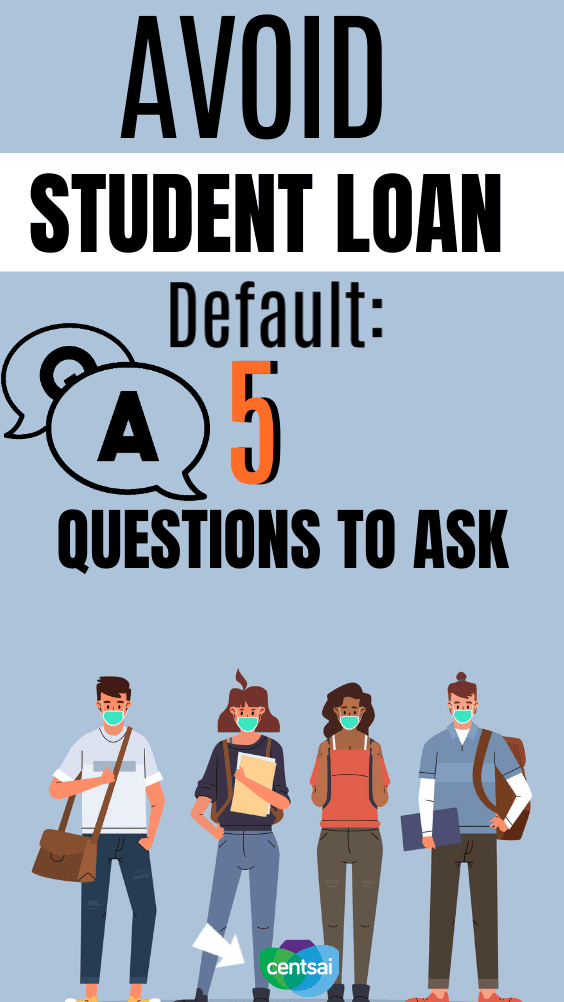
When I graduated college, I did not know about student loan default. I did know that I’d have to pay back my student loans. The problem? I didn’t have a clue how much I owed, nor did I know how to go about paying them back.
You see, all throughout college I buried my head in the sand. Paying off debt was something I’d do “later.” As an 18-year-old just entering college, it’s hard to get a firm understanding of exactly what your student loans entail.
If you’re looking for ways to fund your undergrad or grad years, here are a few popular student loans to consider:
Federal Student Loans
- Federal Direct Subsidized Loans: Applying for loans via the Free Application for Federal Student Aid (FAFSA) is the go-to first step for any student seeking a student loan. Subsidized loans don’t accrue interest while you study and have a capped interest rate of 2.75 percent for undergraduates accepting loans in 2020, per the Federal Student Aid (FSA) website, making them more affordable than most private offerings.
- Federal Direct Unsubsidized Loans: Federal unsubsidized loans come with the same interest rate as their subsidized counterparts, but require the borrower to pay all interest (including the amounts accrued while studying). Despite this, their rates are usually lower than private offerings — plus most federal loans qualify for income-based repayment plans.
- Federal PLUS Loans: These federal loans are designed to cover amounts not already paid for via other direct loans. The debt from these loans falls to the parents of the student for undergraduates, though graduate students can also qualify for them provided they meet certain criteria. Their interest rate is capped at 3 percent for 2020.
Private Student Loans
- Ascent Private Student Loans offers future income based-loans and loans for students with good credit that don’t require a cosigner.
- College Ave Student Loans offers one of the most affordable variable APR rates (between 1.24 percent to 11.98 percent), depending on your credit score, payment history, and other factors. There are no application or origination fees, and you get an instant credit decision after applying.
- Earnest Private Student Loans also offers competitive variable APR rates, promises borrowers a nine-month grace period (three months longer than most lenders offer), and allows borrowers the option of skipping a payment once every 12 months — but be warned that skipped payments will still accrue interest and may extend your repayment term.
- SoFi Private Student Loans may be a solid bet for individuals who have a good credit history — qualified borrowers can obtain a fixed rate loan for as low as 4.23 percent.
Even with exit counseling, the student loan repayment process might seem vague and intimidating. And this lack of awareness is troubling when you consider that 34 percent of students borrow money to pay for college, according to a study by student loan servicer Sallie Mae.
Start by Using This Free Calculator
Truth be told, many students are faced with varying degrees of confusion regarding student loan repayment after graduation. So, whether you are a college student with student loans, recently graduated, or are currently paying back your student loans, here are five questions you should ask to ensure your debt is handled efficiently and safely:
1. Who Is Your Loan Servicer?
When it was time to make my first payment on my student loan, I scrambled. “Wait, who do I pay this to?” I wondered.
Knowing who your loan servicer is super important to avoiding student loan default. I was confused because I didn’t realize that my lender and my loan servicer were two different entities.
A lender is the organization who gives the borrower their funds, while a loan servicer is a third party that actually handles collecting payments. After your loan is disbursed, the loan servicer becomes the point of contact for you and your lender.
You should keep in contact with your loan servicer often, as they’re the ones who you can work with to negotiate repayment terms. To find out your federal loan servicer, you can call the Federal Student Aid Information Center (FSAIC) at 800-433-3243.
Knowing your loan servicer is crucial so you can make on-time payments.
Once I realized that distinction, I was able to find my loan servicer and come up with a repayment plan. If you’re having trouble making payments, make sure you stay in touch with them to discuss your options. They might be able to help you defer payments or apply for forbearance.
2. Are Your Loans Federal or Private?
Not all loans are created equal — there are stark differences between federal student loans and private student loans.
Federal student loans are backed by the government and offer protections and alternative payment plans, such as income-based repayment and loan forgiveness. The government is your lender, while a separate loan servicer is assigned to collect for you.
You can look up your federal loan information from the National Student Loan Data System. You will need to have a Federal Student Aid (FSA) ID to log in.
Private loans can come from a number of different financial institutions, including banks, credit unions, or even the school itself. Private lenders judge your application and offer you terms based on your credit score and history, while federal loans take into account your financial difficulties.
Private loans are generally not subsidized, tend to have stricter repayment terms, and generally have higher interest rates than federal student loans.
3. What Are Your Interest Rates?
Interest can be the gift that keeps on giving — or in this case, taking. Your interest rate determines how much extra money is tacked onto your principal balance. To avoid student loan default, it's important to know your interest rate before signing the loan so that you can calculate how much you’ll pay for your debt over time.
Think about setting a budget for yourself to help make an action plan for your student loans.
For example, I borrowed $18,000 for my undergraduate degree, but it ballooned to over $23,000 because of interest. I hadn’t really thought of how compounding interest would affect my overall balance as time passed.
My graduate PLUS loans were at a much higher interest rate, so I paid those off first. My undergraduate loans were at a low rate of 2.3 percent, whereas my graduate loans were between 6.8 and 7.9 percent.
Due to the Coronavirus pandemic, federal interest rates are temporarily set to zero percent until December 31st, 2020, but this is subject to change. To check the most up-to-date interest rate on your student loan, go to the Federal Student Aid website. Interest rates are set by the federal government and affect your overall repayment.
Keep in mind your repayment schedule, and how time will affect your interest payment, when forming a strategy to pay off your debt. For example, if you take out $35,000 in student loans and pay it over 10 years at a 4 percent interest rate, you’ll pay $7,522.96 in interest.
However, if your interest rate is higher by just 1 percent, that is, if it’s 5 percent, you will end up paying $9,547.52 in interest. That’s a huge difference, so it’s important to understand your interest rate and how much it will cost you.
4. What Is Your Repayment Plan?
Once you graduate college and complete exit counseling, it’s time to set up a repayment plan. Understanding your plan is essential to avoiding student loan default. Most loan servicers automatically sign you up for the Standard Repayment Plan, unless you request another plan.
Paying off your loans in 10 years or less is great — but if you’re struggling paying back federal loans, you may want to apply for an Income-Based Repayment Plan or Income-Contingent Repayment Plan, if you are eligible.
Both plans enable borrowers to pay back their loans using 10 percent of their discretionary income, potentially lessening that monthly loan bill. Opt for a shorter plan if you can, but use the longer options if necessary.
 5. Do You Understand the Consequences of Student Loan Default?
5. Do You Understand the Consequences of Student Loan Default?
You may think that not paying back your student loans is no big deal. But if you stop paying your loans and they go into default, you could be headed toward serious trouble.
If a borrower fails to make a payment after 270 days, your student loans will enter default. Your loans will then be due immediately and will be sent to a collection agency. From there, the agency can tack on more fees and also report your payment as delinquent, which will severely hurt your credit.
On top of that, your wages can be garnished, as can your tax return. Pretty serious stuff, huh?
If you’re having trouble paying, it’s crucial that you get in touch with your loan servicer immediately. You can also look into Public Service Loan Forgiveness and other such loan forgiveness programs.
The Bottom Line
Asking these five key questions is crucial for truly understanding your student loans and managing them effectively.
Whether you’ve taken on $1,000 in debt or $10,000, it’s critical that you take the necessary steps to pay them off as quickly as possible. Ignoring the problem only leads to greater interest payments and risk of default, both of which can create additional headaches beyond the principal amount owed.
While student loans can feel like a burden and affect various areas of your life, they are repayable. Create a plan, get them off your back, and move forward in confidence.
Find Out How Much You Can Pay Off
Additional reporting by Alice Yeung.










